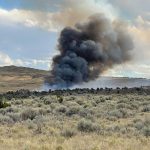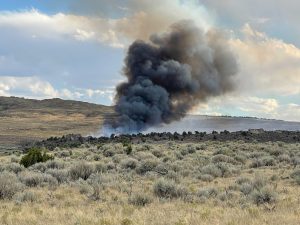Yampa Valley communities steering toward RTA vote in November
Efforts to create a Yampa Valley Regional Transportation Authority took another step forward last Thursday when both Steamboat Springs and Craig held public meetings to discuss the latest updates on the proposed intergovernmental agreement and a November ballot question.
The RTA aims to connect communities across the Yampa Valley through expanded public transit options. The main goal is to improve bus service between communities, add new local routes and make public transportation more reliable and accessible for residents, workers and visitors.
A top objective is introduction of fixed-route bus service on U.S. Highway 131 between Steamboat, Oak Creek and Yampa. Plans also include establishing a new local circulator bus route within Craig, ground transportation options to and from the Yampa Valley Regional Airport and creating park-and-ride lots for commuters accessing both the U.S. Highway 40 bus route and other new routes.
This past spring, all six RTA member jurisdictions – Routt County, Steamboat, Craig, Hayden, Yampa and Oak Creek – approved a draft intergovernmental agreement laying out the structure for how the new transit system would work.
At their most recent meeting, the RTA formation committee, composed of elected representatives from each member jurisdiction, officially recommended to their respective governments that the question of RTA formation be placed on the November 2025 ballot. The upcoming ballot question does not constitute a financial commitment, though voters may see an RTA tax question on the ballot in 2026 or 2027.
“It’s going to be the shortest ballot question you probably have ever seen,” said Bill Ray, consultant for the committee, at the Craig informational meeting. “It simply says, ‘Shall these communities be allowed to enter into an intergovernmental agreement to create the Yampa Valley Regional Transportation Authority?'”
Since the last round of public hearings, there have been only small changes to the agreement.
Previously, Routt County and Steamboat were considered minimum member jurisdictions, meaning both would have to approve the RTA formation; otherwise, even if approved by the other four, the RTA would not proceed.
As of about a month ago, explained Ray and Craig City Councilor Randy Looper, the formation committee amended the agreement such that Routt County approving or not approving the IGA would not be a dealbreaker.
“Steamboat needs to be part of it, because that’s where people are going,” Looper said. But he added that just one of the other five communities would need to approve the formation — not necessarily Routt County.
The formation committee also made it official that property taxes would not be considered as a potential funding mechanism, said Looper, who represents Craig on the committee. Otherwise, aside from slight wording changes, the agreement remains the same.
“One of the things Craig does not really have right now is a way to get around,” Looper said.
“What these buses will be … is probably 12 smaller buses that will figure out a circulator route,” Looper explained of the RTA’s potential benefits to Craig. “It’ll be all community input-based on what stops, how often, what’s involved, and then the cost.”
“The main thing … is increasing the buses to Steamboat back and forth,” Looper continued. “Currently, you have three in the morning and two at night. And what we’re looking at doing … is anywhere from every half-hour to 45 minutes during the prime times — 6 to 9 a.m., and 4 to 7 p.m. — and then hourly during the day and hourly during the night.”
Looper said the regional Steamboat Springs Transit buses that currently run between Steamboat and Craig operate at approximately 90-92% occupancy.
“I’ve talked to people who live in Milner who say that there’s numerous times where the bus is full and they can’t get on,” said Looper.
One Craig attendee mentioned ongoing policy shifts and funding cuts within the federal government and asked whether there was any possibility for the RTA to receive federal dollars.
“Of all the grants that are going away … I see transportation as being the last,” Looper answered. He added that the Colorado Department of Transportation “has a lot of money they’re sitting on. The state can’t steal, basically, like it steals everything else.”
Looper added that regardless of any potential grants — or even if riding the bus is free — “it’s not going to be free to do what we need to do.”
Ray and Looper clarified to the Craig attendees that the RTA is separate from the Mountain Rail project — designed to provide passenger rail service from the Front Range to the Yampa Valley by 2030 — but that the RTA, if formed, would be a stakeholder in future rail planning.
As part of ongoing lift-tax negotiations, Steamboat Resort has agreed to provide an annual contribution of $1 million for the next 20 years as seed money for the RTA, said Looper, which will allow the formation committee to “set the whole system up.”
Ray gave a similar presentation at the Steamboat meeting later in the day, which was attended by Routt County Commissioner Sonja Macys (representing the county on the formation committee), Steamboat Springs City Councilor Michael Buccino (representing the city) and Steamboat Resort Director of Social Responsibility Sarah Jones.
Also in attendance were Yampa Valley Housing Authority board member Catherine Carson, Routt County Planning Commission member Jim DeFrancia and CDOT Grant Programs Oversight Manager Nicole Harty, among others.
One attendee, who described himself as a “citizen interested in transit,” asked fellow stakeholders whether there is any “embryonic” opposition to the RTA thus far.
“No, and it’s been nice,” said Buccino. “At this point, there’s a common sense that, for a community that’s so distant, we really need to do something.”
Buccino added that the formation committee did a survey of over 200 local residents, which saw 70-80% support for the RTA formation.
When it comes to funding, however, that support dropped to 58%, likely a result of the ongoing uncertainty over how much the RTA will cost and through what mechanisms — taxes, grants, motor vehicle registration fees, or others — it will be funded, Buccino said.
“When I hear from people who are like construction contractors, or their truck is basically their mobile office, that ‘I will never use the service,’ my response to that is, ‘OK, if somebody else does, then you’re going to have a parking spot. You’re going to have less traffic,'” said Macys. “So it’s not for everybody, but I don’t think that means that people are necessarily opposed. And I think the ‘what’s in it for me?’ is going to be the next step.”
Harty, who lives in Steamboat, emphasized that the transit options provided by the potential RTA shouldn’t mean “everyone is coming to Steamboat.”
“I think there could be more economic opportunities in some of the outlying communities if we have more options for people to get there,” Harty said.
“Everything that we’re looking at here, this is just the beginning,” said Looper at the Craig meeting. “Over the next year, during formation, we’ll have various meetings with all the communities involved, as far as what you actually want this to do.”


Support Local Journalism

Support Local Journalism
Readers around Craig and Moffat County make the Craig Press’ work possible. Your financial contribution supports our efforts to deliver quality, locally relevant journalism.
Now more than ever, your support is critical to help us keep our community informed about the evolving coronavirus pandemic and the impact it is having locally. Every contribution, however large or small, will make a difference.
Each donation will be used exclusively for the development and creation of increased news coverage.









